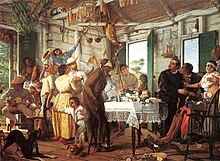| Total population | |
|---|---|
| 1,757 (0.06% of Puerto Rico's population; 2018 estimates, U.S. Census) | |
| Regions with significant populations | |
| San Juan | |
| Languages | |
| Spanish • Chinese (especially Cantonese and Hakka) | |
| Religion | |
| Buddhism • Christianity | |
| Related ethnic groups | |
| Asian Puerto Rican |
| Part of a series on |
| Puerto Ricans |
|---|
 |
| By region or country |
| Subgroups |
| Culture |
| Religion |
| History |
| Language |
|
|
Large-scale Chinese immigration to Puerto Rico and the Caribbean began during the 19th century. Chinese immigrants had to face different obstacles that prohibited or restricted their entry in Puerto Rico.
When Puerto Rico was a Spanish colony, the Spanish government did encourage settlers of non-Hispanic origin. Although the Spanish government changed its policy with the passage of the Royal Decree of Graces (Real Cédula de Gracias) of 1815, the decree was intended to attract non-Hispanic Europeans who were willing to swear their allegiance to the Roman Catholic Church, not non-Christian Asians.
After Spain was forced to cede Puerto Rico to the United States in accordance to the Treaty of Paris of 1898, Chinese immigrants were confronted with the United States' passage of the Chinese Exclusion Act (1882), which forbade the entry and immigration of Chinese nationals to the United States and its territories. After 1943, when the Chinese Exclusion Act was repealed and particularly in the 1950s, when hundreds of Cuban Chinese fled Cuba after Fidel Castro came to power, many more Chinese immigrants went to Puerto Rico.
There are about 1,757 people of Chinese descent in Puerto Rico, as per the 2018 U.S. Census estimates.[1] This number could be higher, especially when taking into consideration those with partial Chinese ancestry, descending from multicultural Puerto Rican-Chinese families.
- ^ "ACS DEMOGRAPHIC AND HOUSING ESTIMATES". U.S. Census. 2019. Retrieved June 5, 2020.
